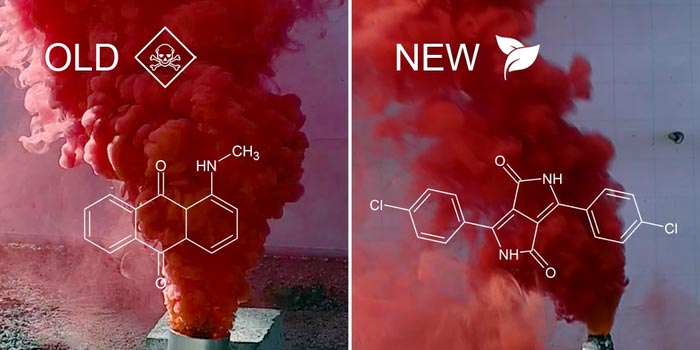A ‘greener’ alternative for red-colored smoke

Dyes currently used for red smoke (left), such as that found in flares, could be toxic, so researchers identified a safer alternative (right).
Credit: Adapted from ACS Sustainable Chemistry & Engineering 2022, DOI: 10.1021/acssuschemeng.2c01000
The red smoke of a flare on a roadway warns motorists to be cautious, but the anthraquinone dyes currently used to produce this smoke are thought to be harmful to human health. Now, researchers reporting in ACS Sustainable Chemistry & Engineering have identified a less toxic, “greener” alternative — an organic dye called pigment red 254 (PR254). It also forms a red-colored smoke cloud more effectively than current dyes, the researchers say.
Commercialized in 1986, diketopyrrolopyrrole (DPP) dyes are used as colorants in car paints (such as the famous “Ferrari red”), optics technologies and other applications. For the purpose of signal smokes, Vojtech Pelikan and colleagues chose the DPP dye PR254, which has a brilliant red color and is less toxic than anthraquinone dyes. In experiments, the researchers showed that a PR254-containing pyrotechnic composition reached a yield of red-colored smoke of 51%, compared with only 48% for the usual anthraquinone dye. PR254 was also more thermally stable than the reference dye, which might allow it to be used in a less toxic heat-generating system, according to the researchers.
The authors acknowledge funding from the University of Pardubice.
The American Chemical Society (ACS) is a nonprofit organization chartered by the U.S. Congress. ACS’ mission is to advance the broader chemistry enterprise and its practitioners for the benefit of Earth and all its people. The Society is a global leader in promoting excellence in science education and providing access to chemistry-related information and research through its multiple research solutions, peer-reviewed journals, scientific conferences, eBooks and weekly news periodical Chemical & Engineering News. ACS journals are among the most cited, most trusted and most read within the scientific literature; however, ACS itself does not conduct chemical research. As a leader in scientific information solutions, its CAS division partners with global innovators to accelerate breakthroughs by curating, connecting and analyzing the world’s scientific knowledge. ACS’ main offices are in Washington, D.C., and Columbus, Ohio.
To automatically receive news releases from the American Chemical Society, contact newsroom@acs.org.
Journal: ACS Sustainable Chemistry & Engineering
DOI: 10.1021/acssuschemeng.2c01000
Article Title: Diketopyrrolopyrrole — A Greener Alternative for Pyrotechnic Smoke Compositions”
Article Publication Date: 30-Mar-2022
Media Contact
Katie Cottingham
American Chemical Society
k_cottingham@acs.org
Office: 301-775-8455
All latest news from the category: Life Sciences and Chemistry
Articles and reports from the Life Sciences and chemistry area deal with applied and basic research into modern biology, chemistry and human medicine.
Valuable information can be found on a range of life sciences fields including bacteriology, biochemistry, bionics, bioinformatics, biophysics, biotechnology, genetics, geobotany, human biology, marine biology, microbiology, molecular biology, cellular biology, zoology, bioinorganic chemistry, microchemistry and environmental chemistry.
Newest articles

Innovative 3D printed scaffolds offer new hope for bone healing
Researchers at the Institute for Bioengineering of Catalonia have developed novel 3D printed PLA-CaP scaffolds that promote blood vessel formation, ensuring better healing and regeneration of bone tissue. Bone is…

The surprising role of gut infection in Alzheimer’s disease
ASU- and Banner Alzheimer’s Institute-led study implicates link between a common virus and the disease, which travels from the gut to the brain and may be a target for antiviral…

Molecular gardening: New enzymes discovered for protein modification pruning
How deubiquitinases USP53 and USP54 cleave long polyubiquitin chains and how the former is linked to liver disease in children. Deubiquitinases (DUBs) are enzymes used by cells to trim protein…



